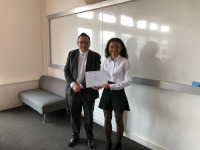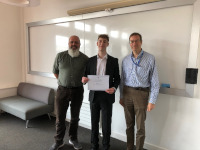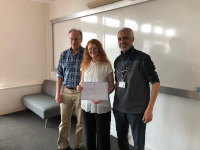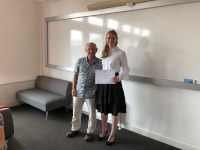Undergraduate project prize winners 2023
MPhys Theoretical Physics – Agnès Ogunjuyigbe
Supervisored by Brendon Lovett
Quantum Transport in 2D Networks
Congratulations to Agnès for winning the MPhys Theoretical physica prize. Agnes was studying how energy can move around a network of pairs of light-absorbing molecules. She found optimal conditions for what the energy of each molecule should be and how strongly they should interact with each other. Her work involved developing a fully quantum mechanical model of the system, and has implications for the design of organic solar cells.
For BSc Physics - Charlie Watson
Characterisation and calibration of the tri-frequency R4AsH radar for accurate volcanic ash signal retrieval
Supervised by Duncan Robertson and Dav Macfarlane
Congratulations to Charlie Watson on his prize winning project to analyse data from the R4AsH radar built by the Millimetre Wave group in collaboration with volcanologists at Lancaster University. R4AsH is designed to improve understanding of remote sensing of atmospheric hazards to aviation from volcanic eruptions. The triple frequency (10, 35 and 94 GHz) system measures the radar reflectivity of falling volcanic ash particles in a laboratory chamber in Lancaster. Charlie’s project used radar data previously taken of metal sphere targets of a variety of diameters. Combining radar component characterisation, theory and system design Charlie was able to calibrate the accuracy of the radar to within a decibel. This is a crucial part of the process for developing R4AsH allowing us to make reliable measurements on volcanic ash.
Project supervisor Dr David Macfarlane said “Charlie was a first class student. He had to learn a lot of radar concepts and theory new to him as well as analysing a system where each of the radar channels had particularly subtle differences. I was impressed at his intuition and initiative throughout the project and he delivered a project displaying a postgraduate level of critical analysis that confirms the accuracy of the R4AsH radar. He did such an excellent job that we employed Charlie to continue working on R4AsH this May to help with further analysis on the particle imaging system used in conjunction with the radar. This included spending a week at Lancaster to help with our first ever runs of dropping and measuring ash from Mount Etna, a moment that has been long delayed by the pandemic. It was great to give Charlie the opportunity to experience working with the system first hand after all his hard weeks of working with raw data from last year. Thanks for all your efforts Charlie and good luck in the future”

For MPhys Physics - Helen Sawyer
Supervised by Graham Smith and Hassan El Mkami
Congraulation to Helen Sawyer for her prize-winning MPhys physics project titled 'Development of new methods to detect electron nuclear interactions'
Helen's project investigated new pulsed EPR methodologies with the aim to enhance the detection of electron-nuclear interactions in paramagnetic systems. This in turn will help getting better insights into the structure of biological molecules, characterising inorganic chemicals and controlling quantum states for quantum information processing. Electron spin echo envelope modulation (ESEEM) is a well established hyperfine technique and in this project Helen investigated it using matched pulses taking the benefit of the Arbitrary Waveform generator (AWG) recently implemented in the High Field EPR spectrometer. Additionally, her use of a state-of-the-art EPR spectrometer known as HiPER enabled a direct observation of the nuclear modulation frequencies of 1H and 2H during the pulse and in its free induction decay (FID) due to the high isolation between transmission and detection. This detection method exhibited favourable comparisons to ELectron-electron DOuble Resonance (ELDOR)-Detected NMR (EDNMR) in terms of both signal strength and data collection time.

BSc: Charlotte Fries
Supervisor – Andrew Cameron
Congratulations to Charlotte Fries for her prize-winning BSc astronomy project, "Is Speedy Mic really two stars?”.
HD 197890 = BO (Speedy) Mic is a very young star, somewhat cooler and less massive than the Sun. It has been the subject of numerous Doppler-imaging and prominence-mapping studies since the discovery of its 8-hour spin period in the 1990s. Early obsrvtions by NASA’s TESS mission, right at the start of the mission in Sector 1, revealed that its light curve is dominated by starspot modulation whose periodogram shows an unusual period splitting. Its angular diameter and parallax yield a radius that appears inconsistent with the spectroscopic rotational broadening and photospheric spin period. High-resolution Doppler imaging studies show an apparent anomaly in the wings of the rotation profile. This evidence all points to the presence of a second star, gravitationally bound to Speedy. Steve Howell obtained speckle interferometry with Gemini South in May/June 2020. Preliminary analysis appeared to confirm binarity.
Charlotte’s project thus involved tying together a bewildering range of clues. These included the evidence for 2 spin periods in the TESS light curve, the inconsistency between different measures of the stellar radius; the speckle results from Gemini South; and the 1000-day orbit derived by the Gaia team from the “wobble” of the unresolved centre of light of the system. Using stellar evolutionary models to estimate the plausible stellar masses and luminosities that could fit all of these observations simultaneously, Charlotte derived a comprehensive model showing conclusively not just that Speedy Mic is a binary, but resolving all of the observational discrepancies and determining the shape and orientation of the orbit.

MPhys: Alison McIntosh
Supervisor – Moira Jardine
Congratulations to Alison McIntosh for her prize-winning MPhys astronomy project, "Small stars, big prominences: Investigating the angular momentum removed from rapidly rotating stars via slingshot prominence ejections”.
When the Sun was younger it rotated faster and generated a much stronger magnetic field. The centrifugal effect of that rapid rotation drove the gas of its outer atmosphere into the summits of the tallest magnetic loops, where it condensed to form cool clouds known as slingshot prominences. When these were intermittently ejected they carried away not only mass but also angular momentum. Over time, this would have slowed down the Sun’s rotation rate. The solar wind would also have contributed to this spin down - but which effect was more important? Alison's project modelled the support of these clouds and determined the rate at which their ejection could spin down the Sun. It concluded that during the period when the Sun was at its most active - long before the Earth had life - these slingshot prominences were a significant factor in slowing the Sun’s rotation and reducing its magnetic activity.
